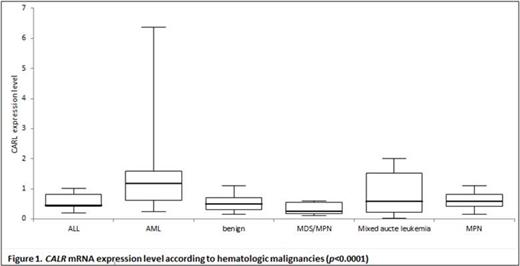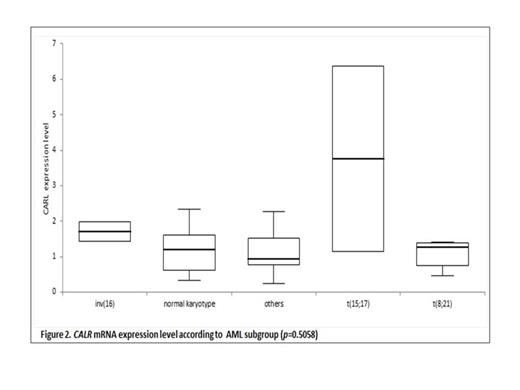Abstract
Background: Calreticulin (CARL) is a multifunctional protein that plays a role in calcium homeostasis and chaperoning molecular processes. Recently, somatic mutations in the gene CALR have been found in 20-25% of patients with essential thrombocythemia or primary myelofibrosis with nonmutated JAK2 and MPL and the JAK-STAT pathway appears to be activated in MPN with mutated CALR. In the other hand, CARL overexpression has been reported in a variety of solid tumors and is also associated with a more invasive and advanced malignant processes [Zamanian M et al, Pathol Oncol Res 2013]. The objective of this work was to evaluate the expression levels of the CALR and clinicopathologic characteristics in patients with a variety of hematologic malignancies. To the best of our knowledge, this is the first study to compare CALR expression levels among hematologic malignancies.
Methods: The study group included 127 patients having diagnosed as malignant or benign hematologic diseases in Mokdong Hospital, Ewha Womans University School of Medicine, Seoul, Korea between 2010 and 2014 ; 44 AML, 16 acute lymphoblastic leukemia (ALL), 5 mixed phenotype acute leukemia, 35 MPN or (7 polycythemia vera, 14 ET, 4 MPN-U, 10 CML), 5 MDS/MPN, and 22 benign hematologic condition. RNA was extracted using bone marrow aspirates or peripheral blood at diagnosis. CALR mRNA levels were measured through quantitative real time-PCR targeting CRLR gene in exon 7-8 boundary (Taqman Gene Expression Assays, Life Technologies). As a reference control, G6PDH mRNA was simultaneously processed in the same samples and peripheral bloods obtained from 4 different normal volunteer donors were pooled for normal control. The relative quantification of CALR mRNA is calculated and the association between CALR expression levels and clinicopathologic parameters were reviewed based on the medical records retrospectively. All statistical analyses were performed using Analyse-it, 3.70 (Analyse-it Software, Ltd, UK).
Results: Higher expression of CALR mRNA level was noted in AML patients (median:1.18, range:0.24-6.38) when compared with ALL (median:0.44, range:0.19-1.02), mixed phenotype acute leukemia (median:0.58, range:0.01-2.01), MPN (median:0.58, range:0.14-1.10), MDS/MPN (median:0.25, range:0.10-0.60) and benign-hematologic conditions (median:0.50, range:0.14-1.10) (p<0.0001) (Fig.1). Although calcium depletion is regarded as an important activator of the CALR gene promoter, we were not able to identify any significant correlation between calcium level and CARL mRNA level (r= -0.236, p= 0.0146). In addition, no correlation was detectable between CARL mRNA level and hemoglobin (r= -0.263, p= 0.0028), WBC count (r= 0.009, p= 0.9225) and platelet count (r= -0.193, p= 0.0300). No difference of CARL expression level was noted according to the WHO 2008 AML sub-classification (Fig.2). When gene expression variable was categorized in four intervals (<0.5, 0.5< <1.0, 1.0< <2.0, and >2) in AML patients, no significant differences in the gene expression level were seen in relation to the age, gender, calcium level, hemoglobin, WBC count, platelet count, blast count, relapse rate and overall survival. Of 24 MPN patients (7 polycythemia vera, 14 ET, 4 MPN-U), CALR gene expression was higher in JAK2 non-mutated patients (median:0.76, range:0.14-0.89) than JAK2 mutated patients (median:0.58, range:0.23-1.10 ), but not statistically significant, probably due to the limited number of samples studied (p=0.8019).
Conclusion: This study showed that the up-regulated expression of CALR in AML compared with other hematologic malignancies was notable, but the association of CALR expression and clinicopathologic characteristics were not found. The exact roles of CALR is yet be clarified due to its diverse interactions into various cellular processes and signaling pathways and further studies are needed to investigate the clinical relevance of CALR expression in hematologic malignancies.
No relevant conflicts of interest to declare.
Author notes
Asterisk with author names denotes non-ASH members.



